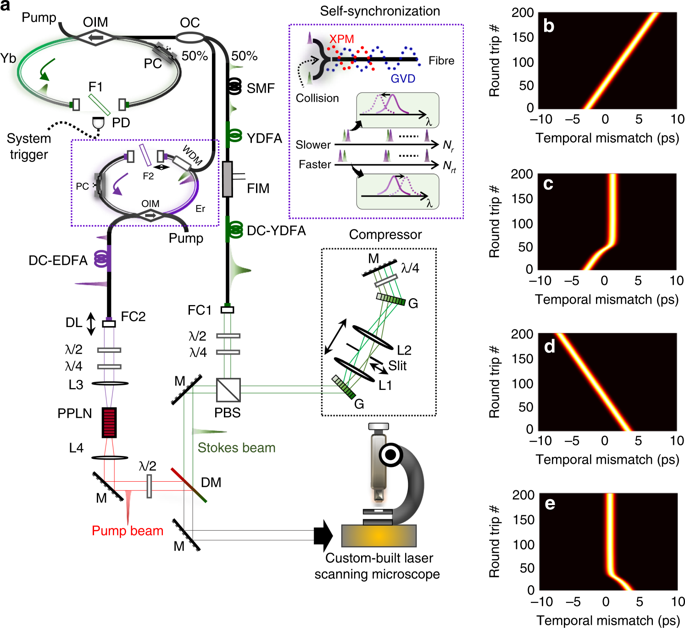Light: Science & Applications ( IF 20.6 ) Pub Date : 2020-02-24 , DOI: 10.1038/s41377-020-0259-2 Cihang Kong , Christian Pilger , Henning Hachmeister , Xiaoming Wei , Tom H. Cheung , Cora S. W. Lai , Nikki P. Lee , Kevin. K. Tsia , Kenneth K. Y. Wong , Thomas Huser

|
Coherent Raman scattering (CRS) microscopy is widely recognized as a powerful tool for tackling biomedical problems based on its chemically specific label-free contrast, high spatial and spectral resolution, and high sensitivity. However, the clinical translation of CRS imaging technologies has long been hindered by traditional solid-state lasers with environmentally sensitive operations and large footprints. Ultrafast fibre lasers can potentially overcome these shortcomings but have not yet been fully exploited for CRS imaging, as previous implementations have suffered from high intensity noise, a narrow tuning range and low power, resulting in low image qualities and slow imaging speeds. Here, we present a novel high-power self-synchronized two-colour pulsed fibre laser that achieves excellent performance in terms of intensity stability (improved by 50 dB), timing jitter (24.3 fs), average power fluctuation (<0.5%), modulation depth (>20 dB) and pulse width variation (<1.8%) over an extended wavenumber range (2700–3550 cm−1). The versatility of the laser source enables, for the first time, high-contrast, fast CRS imaging without complicated noise reduction via balanced detection schemes. These capabilities are demonstrated in this work by imaging a wide range of species such as living human cells and mouse arterial tissues and performing multimodal nonlinear imaging of mouse tail, kidney and brain tissue sections by utilizing second-harmonic generation and two-photon excited fluorescence, which provides multiple optical contrast mechanisms simultaneously and maximizes the gathered information content for biological visualization and medical diagnosis. This work also establishes a general scenario for remodelling existing lasers into synchronized two-colour lasers and thus promotes a wider popularization and application of CRS imaging technologies.
中文翻译:

使用自同步双色光纤激光器通过相干拉曼散射进行高对比度,快速化学成像
相干拉曼散射(CRS)显微镜凭借其无化学特异性的无标记对比度,高空间和光谱分辨率以及高灵敏度,被广泛认为是解决生物医学问题的有力工具。但是,CRS成像技术的临床翻译长期以来一直受到具有环境敏感操作和占用空间大的传统固态激光器的阻碍。超快光纤激光器可以克服这些缺点,但由于以前的实现方式遭受了高强度噪声,狭窄的调谐范围和低功耗的困扰,导致图像质量下降和成像速度慢,因此尚未完全用于CRS成像。这里,-1)。激光源的多功能性首次实现了高对比度,快速的CRS成像,而无需通过平衡的检测方案降低复杂的噪声。通过对广泛的物种(例如活的人类细胞和小鼠动脉组织)进行成像,并利用二次谐波产生和双光子激发的荧光对小鼠尾巴,肾脏和脑组织切片进行多峰非线性成像,证明了这些功能。同时提供多种光学对比机制,并最大限度地提高了收集的信息内容,以进行生物可视化和医学诊断。这项工作还建立了将现有激光器重塑为同步双色激光器的一般方案,从而促进了CRS成像技术的广泛普及和应用。











































 京公网安备 11010802027423号
京公网安备 11010802027423号